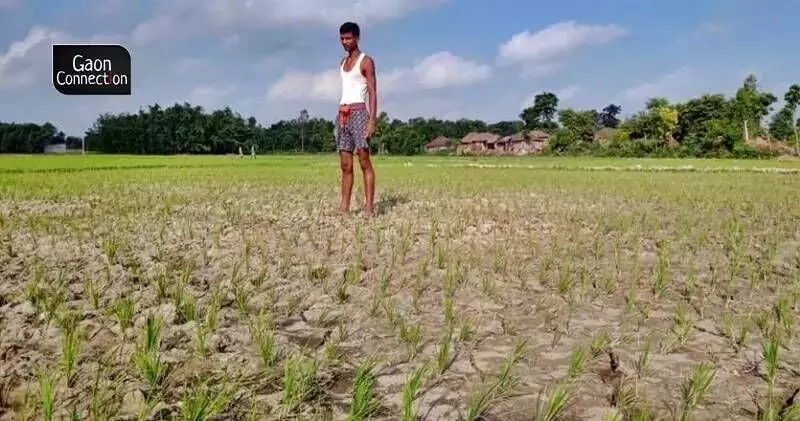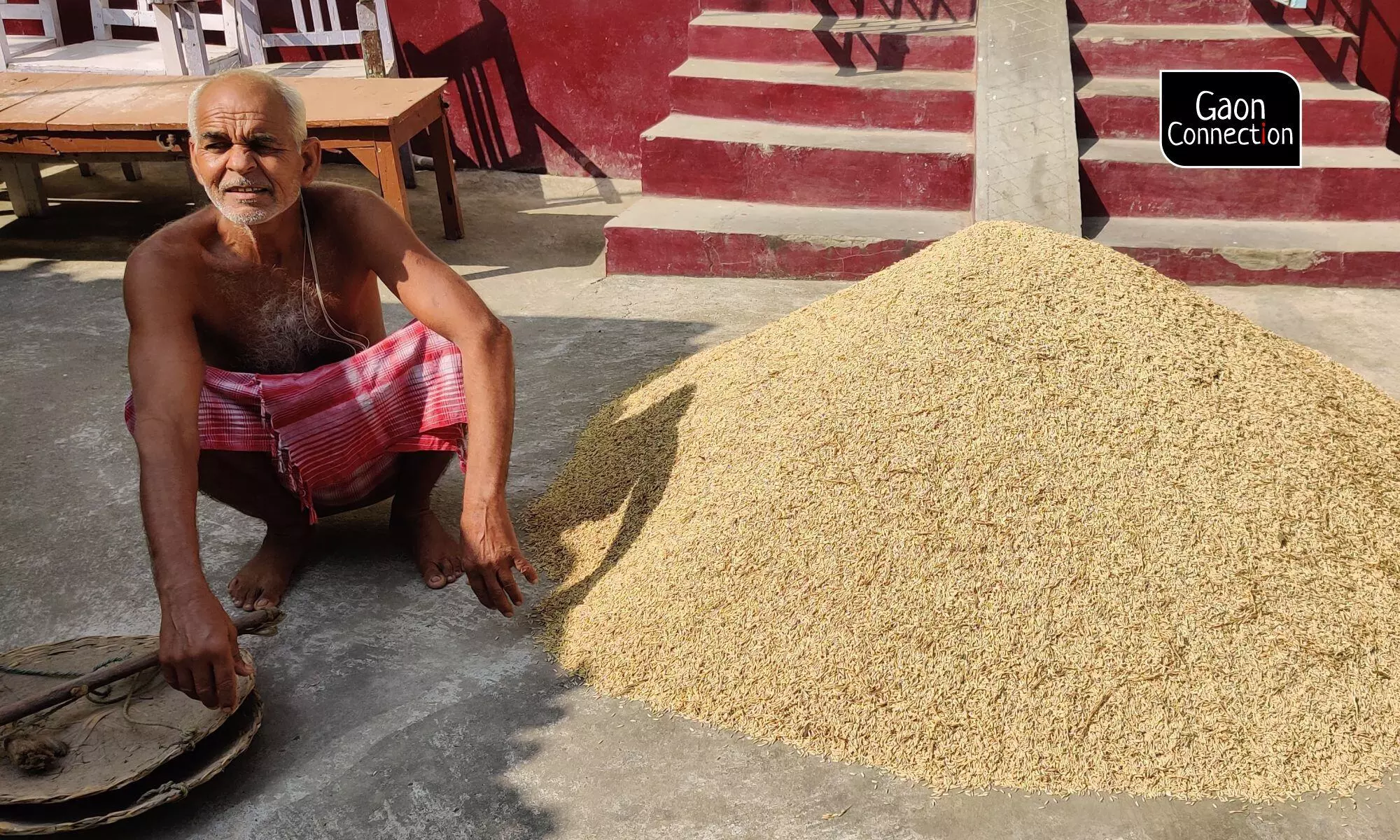Four months after the Indian government prohibited the export of wheat in the wake of reduced production due to early heatwaves this year, a reduction in the acreage of paddy due to rainfall deficit in key paddy growing states has resulted in considerable unease.
According to the progress report of the area coverage under kharif (summer) crops released by the Union Ministry of Agriculture and Farmers’ Welfare, as on August 26, there is a reduction of 2,345,000 hectares of paddy’s sowing area in the country as compared to last year’s acreage, which translated as a shortfall by 7.56 per cent.

The reduction in the sowing area is attributed to a rainfall deficit in the major rice producing states situated in the Indo-Gangetic plains. A large number of farmers in the country depend on the monsoon rainfall to grow crops as they lack other irrigation facilities.
According to the India Meteorological Department (IMD), between June 1 and September 2 this year, Uttar Pradesh has registered a rainfall deficit of minus 44 per cent. In the neighbouring state of Bihar, the rainfall deficit is minus 38 per cent and in Jharkhand it is minus 26 per cent.
Punjab and Haryana have also reported a rainfall deficit of minus 14 per cent and minus 9 per cent respectively.

The reduction in the sowing area is attributed to a rainfall deficit in the major rice producing states situated in the Indo-Gangetic plains. Photo by Rahul Kumar
According to a statement on the food security situation issued by the World Bank last month, rice exporters in India are concerned that a shortfall in the production of paddy can lead the government to impose a ban on rice exports.
“Exporters, concerned that export restrictions will be introduced (as has been done for wheat), are moving quickly to open letters of credit and have signed contracts to export 1 million tonnes of rice from June through September 2022,” the World Bank update issued on August 11 stated.
Also Read: Deficient rainfall and low paddy sowing fuels labour migration in Jharkhand
Also, a Reuters report mentioned on August 26 that India is considering ‘whether to restrict exports of 100% broken rice’. After prohibiting wheat exports by traders on May 13, the government has recently also banned the export of wheat flour and semolina (rawa) to curb the rising wheat prices for an indefinite period, as notified by the Directorate General of Foreign Trade on August 28.
Since early this year, Gaon Connection has been reporting on the impact of early heatwaves on the wheat crop and the prohibition of wheat exports.
However, opinion on the possibility of rice export ban by India is divided.
Risk of export ban?
According to market analysis conducted by Nomura Holdings, a Tokyo-based financial services company, the risk of the Union government banning the export of rice is ‘non-negligible’.
“We think the risk is non-negligible. Following the Russia-Ukraine war, soaring maize prices prompted a shift towards using broken rice as animal feed, with rising feed costs adding to higher meat prices. India’s rice production this season may also be lower. Sowing of rice during the ongoing kharif season is 6% lower than last year, due to deficient rains in some key rice-growing states. This has pushed up domestic rice prices in India,” a market research document authored by economists Sonal Verma and Si Ying Toh mentioned on August 30.
However, the research analysis also mentioned that the government has ample rice buffer stocks but lower procurement of wheat due to the crop damage caused by heatwaves has increased the burden on rice.

The lowering of acreage of rice in India is juxtaposed with a severe drought in the eastern region of Africa. Photo by Umesh Kumar Ray
“…which means a likely drawdown of rice buffers and higher local rice prices in coming months, in our view,” it added.
Also Read: Rising exports, low procurement and a drop in wheat yield: Is India headed for a wheat shortage?
However, when Gaon Connection contacted Vinod Kaul, executive director of the New Delhi-based All India Rice Exporter’s Association, he stated that the news reports citing the possibility of a ban on rice exports are not only speculative but also misleading.
“It is all media reports which are creating panic. The government is not going to impose any ban on rice exports. The stocks maintained by the Union government are sufficient enough and there is no need for the government to impose any ban or restrictions on the export of rice,” Kaul told Gaon Connection.
Also, Vishal Tiwari, a rice exporter from Uttar Pradesh’s Mirzapur district told Gaon Connection that the chances of a ban on rice export on the lines of the already existing ban on the export of wheat is an extremely remote possibility.

The ramifications of lower paddy production in India transcend the national boundaries. Photo by Umesh Kumar Ray
“The government imposed a ban on wheat when it was running on low stocks for the free ration schemes and PDS. My sources in the government have assured me that the rice stocks are sufficient,” Tiwari said.
“Also, the demand for rice is not as much as wheat within the country that’s why we export it to other countries. Wheat is needed not only as a staple but its flour [maida] is also used in the bakery and confectionery goods which is not the case with rice. With all these factors, a ban on export is very less likely,” the exporter added.
Also Read: “We eat roti with salt”: High inflation has shrunk the food basket of rural Indians
Food security implications
Balram, a Jharkhand-based food activist from the Right to Food Campaign, told Gaon Connection that the welfare scheme – Pradhan Mantri Garib Kalyan Yojana – to provide free food rations to the poor section needs to be extended further and the low acreage of paddy is set to cause a setback to the country’s food security. At present, the free ration scheme is set to expire in September.
“We are conducting a survey to understand the expenditure sustained by the poor households in affording food. Our initial assessment shows that almost 80 per cent of the earnings are being spent to afford food. In such a situation, the government should extend the free ration scheme as it is coming to an end in September,” he said.
The Pradhan Mantri Garib Kalyan Yojana was launched in April 2020 to help the poor sections of the society who are yet to recover from the economic devastation caused by the COVID-19 pandemic. Under this scheme, five kilogrammes of grains a month are distributed to individuals belonging to poor sections of the society on a monthly basis.
“In such a situation, a reduction in the acreage of paddy will definitely affect the Centre’s food stocks. The government needs to come up with agricultural plans to reduce the risk of crop damage due to the adversely changing climate, otherwise the food crisis can get worse with every passing year,” the food activist added.
Also Read: Bonanza for Indian wheat exporters, but cuts in wheat quota under the PM Garib Kalyan Anna Yojana
Global concern
The ramifications of lower paddy production in India transcend the national boundaries. As per the United States Food Administration, India is the largest exporter of rice and supplies 40 per cent of the total demand of rice across the world.
The lowering of acreage of rice in India is juxtaposed with a severe drought in the eastern region of Africa. As per the United Nations report on the drought in the region, the countries of Djibouti, Eritrea, Ethiopia, Kenya and Somalia are reeling under famine.
“Soaring food prices across the world – made worse by the war in Ukraine – and four failed consecutive rainy seasons resulting in an entrenched drought crisis have forced families across Djibouti, Eritrea, Ethiopia, Kenya and Somalia to leave everything behind in search of food and water, and put their health, safety and education at risk. Children face a ‘perfect storm’ for famine to set in if we don’t act now. Millions could lose their lives if we cannot get life-saving food into their hands quickly enough,” the report published in July, 2022 mentions.












